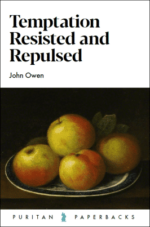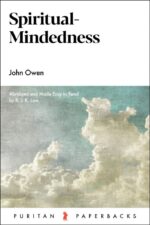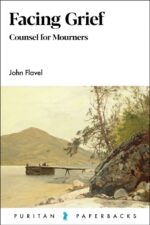save
$1.05The Bruised Reed (Richard Sibbes) (#26)
$8.95$10.00
“I shall never cease to be grateful to Richard Sibbes, who was a balm to my soul at a period in my life when I was overworked and badly overtired, and therefore subject in an unusual manner to the onslaughts of the devil. I found at that time that Richard Sibbes who was known in London in the early 17th century as “the Heavenly Doctor Sibbes” was an unfailing remedy. The Bruised Reed quietened, soothed, comforted, encouraged and healed me.” — Dr. Martyn Lloyd-Jones
Richard Sibbes (1577-1635), one of the most influential figures in the Puritan movement during the earlier years of the seventeenth century, was renowned for the rich quality of his ministry. The Bruised Reed shows why he was known among his contemporaries as ‘the sweet dropper’.
The Bruised Reed is now issued for the first time in a smaller format in the Puritan Paperbacks series. Some of the language and punctuation have been modernized to make the work more accessible.
In stock
The Bruised Reed
Richard Sibbes (1577-1635), one of the most influential figures in the Puritan movement during the earlier years of the seventeenth century, was renowned for the rich quality of his ministry. The Bruised Reed shows why he was known among his contemporaries as ‘the sweet dropper’.
The Bruised Reed is now issued for the first time in a smaller format in the Puritan Paperbacks series. Some of the language and punctuation have been modernized to make the work more accessible.
Endorsement from “the Doctor” himself:
“I shall never cease to be grateful to Richard Sibbes, who was a balm to my soul at a period in my life when I was overworked and badly overtired, and therefore subject in an unusual manner to the onslaughts of the devil. I found at that time that Richard Sibbes who was known in London in the early 17th century as “the Heavenly Doctor Sibbes” was an unfailing remedy. The Bruised Reed quietened, soothed, comforted, encouraged and healed me.” — Dr. Martyn Lloyd-Jones
A Review from Nick Roark
In his book The Bruised Reed and Smoking Flax, the Puritan preacher Richard Sibbes provides a tenderhearted, Christ-exalting exposition and application of Isaiah 42:1-3. Since its initial publication in 1630, The Bruised Reed has been a source of encouragement to dejected sinners and struggling saints alike.
Sibbes follows Matthew’s interpretation of this text, seeing it to be fulfilled in the life and ministry of Jesus Christ (Matt. 12:18-20). His exposition breaks down into three basic parts: (1) Christ will not break the bruised reed; (2) Christ will not quench the smoking flax; (3) Christ will not do either of these things until he has sent forth judgment into victory. Sibbes explains the main text under these three headings and then intersperses searching application throughout the book.
Why should the busy pastor spend time reading a book written by a preacher in London nearly four centuries ago? Well, Sibbes did know a thing or two about preaching. He regularly wrote out his sermons and at the time of his death in 1635 he left over two million words on paper. The Bruised Reed is still considered to be a classic of Puritan devotion. Sibbes became known as the ‘heavenly Doctor Sibbes,’ due in part to his God-honouring preaching and God-fearing manner of life. A couplet was written about Sibbes after his death that captures this well:
Of that good man let this high praise be given:
Heaven was in him before he was in heaven.
Four Lessons to Learn from the Heavenly Doctor
If you have never read Sibbes before, then you will find much to glean from a careful and prayerful reading of The Bruised Reed. Here are four ways the heavenly Dr Sibbes can help your soul and improve your preaching.
1. BE DOGGEDLY PERSISTENT IN EXPOSITING THE LOVELINESS AND SWEETNESS AND GLORY OF JESUS CHRIST
The first lesson to learn from Sibbes is to be doggedly persistent in expositing the loveliness and sweetness and glory of Jesus Christ. It is not enough for the preacher to preach against sin. He should also hold forth the wonder and glory of the Saviour.
Sibbes understands what Scripture teaches about the depravity of the fallen human heart. He writes, ‘It is a very hard thing to bring a dull and an evasive heart to cry with feeling for mercy. Our hearts, like criminals, until they be beaten from all evasions, never cry for mercy of the Judge’ (4). But Sibbes doesn’t just point out the sinfulness in the heart of man. He wants the heart of his readers to be captivated by Christ. According to Sibbes, God mercifully bruises believers in order to soften their hardheartedness and awaken love for Christ. He writes: ‘This bruising makes us set a high price upon Christ. Then the gospel becomes the gospel indeed; then the fig-leaves of morality will do us no good’ (4).
This kind of Christ-centredness is found throughout the book:
There is more mercy in Christ than sin in us (13).
We are only poor for this reason, that we do not know our riches in Christ (61).
In Christ all perfections of mercy and love meet (62).
He who died for his enemies, will he refuse those, the desire of whose soul is towards him? (65).
Whatever may be wished for in an all-sufficient comforter is all to be found in Christ (66).
Sibbes reminds pastors of the importance of always keeping Christ at the centre of our preaching, teaching, and evangelism. He models to all preachers what it means to consistently point our hearers away from themselves and directly to Christ. Godly introspection is a good thing but looking inward is only helpful for a season. Pastors should consistently focus the attention of both believers and unbelievers on Jesus Christ, the one who is the centrepiece of our proclamation (Col. 1:28).
Sibbes reminds preachers to consistently exposit the beauty and loveliness and glory of Christ. Preach against sin but never fail to shine the spotlight of your sermon on Jesus.
2. APPLY THE BIBLE TO THE HEART AND THE HEAD TOGETHER
The second lesson to learn from Sibbes is to apply the Bible to the heart and the head together. Some of the best sections of The Bruised Reed are those in which Sibbes draws out heart-searching application. The Puritans were masters of affectionate, discerning, wise biblical application. Yet even by Puritan standards, Sibbes seems to be exceptional at application. There are nineteen separate ‘use’ sections in The Bruised Reed where Sibbes provides detailed application from the biblical text.
But it’s not the quantity of application that one notices when reading The Bruised Reed — it’s the quality. If this book only included the ‘use’ sections, then pastors would still profit greatly from it. If you feel that faithful application is a weakness in your preaching, then learn from Sibbes. As you read, note the way he faithfully instructs the mind and applies the biblical text directly to the heart.
The most affecting section in my rereading of this book was an application section entitled ‘Weakness Should Not Keep Us From Duty’ (50-51). We know from Matthew 7:7-11 that believers should persevere in praying to our gracious heavenly Father. But instead of whipping the conscience with bald imperatives to pray, Sibbes beckons them to pray by casting pearl indicatives with both hands.
To quote him:
God will hear the desires of his own Spirit in you . . . God can pick sense out of a confused prayer. These desires cry louder in his ears than your sins . . . These stirrings touch the heart of God and melt him into compassion towards us, when they come from the Spirit of adoption, and from a striving to be better . . . [L]ook to the promises . . . God accepts our prayers, though weak, because we are his own children . . . There is never a holy sigh, never a tear we shed, which is lost . . . By prayer we learn to pray . . . God in Christ will cast a gracious eye upon that which is his own. (50-51)
Sibbes refuses to separate head and heart in his application of Scripture. He is adamant that the Christian maintain the vital connection between knowledge and affection. Sibbes doesn’t point his readers toward cold, calculating, dead orthodoxy or toward doctrine-less, experience-focused emotionalism. The affections ought to be raised as high as they possibly can, provided they are raised solely according with the truth.
In Sibbes’ writing, head and heart aren’t in opposition. Rather, they assist each other to truly know and love Christ. Sibbes writes: ‘Because knowledge and affection mutually help one another, it is good to keep up our affections of love and delight by all sweet inducements and divine encouragements; for what the heart likes best, the mind studies most’ (103). So, Sibbes provides a good check for our own preaching. Do we aim to raise the affections of our hearers by way of filling their understandings with fresh, glorious and joyous truth about Jesus? Sibbes is right. If our hearts love Christ, we will study Christ.
3. MAKE COMPLICATED IDEAS PLAIN
A third lesson to learn from Sibbes is to make complicated ideas plain. Sibbes does this powerfully, with an economy of words. For example, Sibbes asks the probing question, ‘What is the source of discouragements to duties?’ At this point, one might expect a complicated reply. But instead, Sibbes gives this simple, three-fold answer: ‘Not from the Father . . . Not from Christ . . . Not from the Spirit . . . Discouragements, then, must come from ourselves and from Satan, who labours to fasten on us a loathing of duty’ (56-57). If you feel discouraged about going to God in prayer, then Sibbes exhorts you to preach to yourself that this discouraging lie is coming from your flesh or from the Devil, the father of lies. The holy, loving Triune God longs for his children to boldly draw near to his throne of grace.
Sibbes omits needless words. This helps to make his sermons refreshing and punchy and memorable and clear. It’s no wonder, then, that those who heard Sibbes preach lovingly referred to him as ‘The Sweet Dropper.’
4. COUNSEL SAINTS AND SINNERS WITH BIBLICAL WISDOM
Fourth, Sibbes teaches us to counsel saints and sinners with biblical wisdom. The Bruised Reed is brimming with examples of basic, helpful, pastoral counsel using warnings and promises, law and gospel.
To the wandering saint who lacks assurance, Sibbes writes: ‘Wilful breaches in sanctification will much hinder the sense of our justification’ (61).
To the stubborn saint who is blinded to areas of sin, Sibbes writes: ‘[W]henever he savingly shines on the understanding he gives a soft and pliable heart . . . Where grace has subdued the heart, unruly passions do not cast such a mist before the understanding that it does not see in particular cases what is best’ (88-89).
To the struggling saint who is clinging to Christ by faith, Sibbes writes: ‘A little thing in the hand of a giant will do great things. A little faith strengthened by Christ will work wonders’ (92).
These pastoral nuggets are wonderfully helpful in teaching another basic lesson. If we want to give wise, biblical counsel to others, we mainly need to know our Bibles better. Knowing our Bibles better will help us to know our own wicked hearts better and ultimately know the Saviour better.
A Feast for the Soul
According to Richard Baxter, the reading of The Bruised Reed was instrumental in his own conversion to Christ. The ‘heavenly Doctor Sibbes’ was also used of God to be an ‘unfailing remedy’ and balm to the soul of an overworked and overtired Martyn Lloyd-Jones. Lloyd-Jones wrote that during a particularly grueling season of pastoral ministry, ‘The Bruised Reed quieted, soothed, comforted, encouraged and healed me.’
I trust that you too will find The Bruised Reed to be a feast for your own soul. Richard Sibbes is a gift from Christ to his church in the way he models affectionate, Christ-centred preaching and application. What a joy it is to keep his company through his writings and to learn from him to love our Saviour more deeply and proclaim his gospel more faithfully.












